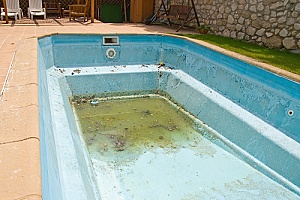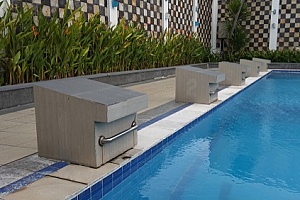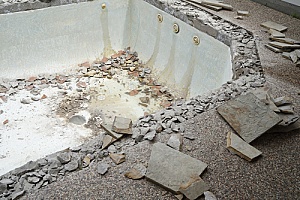 Swimming pools offer homeowners the best thrills and fun; however, they aren’t everlasting. If your swimming pool is quite old or damaged, you’ll need to demolish it; and to do this, you’ll require the services of an experienced pool demolition and removal company. Homeowners demolish their pools for two primary reasons which are: To completely get rid of the pool for specific purposes, or to demolish the old pool to install a new one. Like earlier stated, all these can be done by Dirt Connections, an experienced pool demolition company.
Swimming pools offer homeowners the best thrills and fun; however, they aren’t everlasting. If your swimming pool is quite old or damaged, you’ll need to demolish it; and to do this, you’ll require the services of an experienced pool demolition and removal company. Homeowners demolish their pools for two primary reasons which are: To completely get rid of the pool for specific purposes, or to demolish the old pool to install a new one. Like earlier stated, all these can be done by Dirt Connections, an experienced pool demolition company.
There are three basic swimming pool types.
-
- Above-ground: This type of pool is constructed above the existing ground level. Above-ground pools are always bought in kit form and can be either destroyed or assembled with normal hand tools.
-
- In-ground: These types of pools are generally constructed with reinforced concrete or fiberglass.
-
- Semi-in-ground: A semi-in-ground pool is partially constructed within the ground, and removal would require the use of filling material to restore the ground level.
Demolishing pools isn’t quite as easy as it seems; there exist several risks involved in carrying out this act, including few considerations to remember when thinking of removing a swimming pool.
- Semi-in-ground: A semi-in-ground pool is partially constructed within the ground, and removal would require the use of filling material to restore the ground level.
-
-
- If later in the future, you decide to sell your apartment, you much indicate that you removed a swimming pool. Failure to make such known may attract fines and penalties.
-
-
-
- Removing a swimming pool incorrectly may result in certain structural damages to your yard and your home in general. It can unintentionally create a sinkhole, corrupt the groundwater, resulting in lingering seepage and pooling water, and other forms of water spoilage you can think of.
-
-
- Ultimately, by removing a swimming pool from your property, you may not be legally allowed to replace it with another structure. There exist several laws in place, preventing structures from being erected where a pool was due because of safety reasons.
Types of Swimming Pool Removal
So, as a homeowner, you’ve finally chosen to get rid of that pool of yours. Suddenly, you are confronted with several questions that get you worried. How will your pool removal be executed? Several cities tolerate a partial collapse and fill, complete removal of concrete and rebar, and then backfill with the direction of a licensed Geotechnical soil Engineer.
The removal of a swimming pool involves a lot of steps, irrespective of the pool type (e.g., in-ground and above ground). By draining out the water, with the aid of unique machinery to destroy the concrete and gather dirt and debris.
There exist two main methods adopted to remove a swimming pool; these methods are a partial pool removal and a full pool removal. Though various pool demolition companies execute this method using different techniques, the aim still remains the same. Below is a short explanation of each method of pool removal.
Partial Removal and Non-Engineered Fill (Sides Broken Down)
The Process
 This is a prevalent type of removal method. This technique includes making holes underneath the bottom of the swimming pool, breaking the flanks (bond beam) down 18″-36″ from grade, then backfilling and compacting follows without an engineering supervision.
This is a prevalent type of removal method. This technique includes making holes underneath the bottom of the swimming pool, breaking the flanks (bond beam) down 18″-36″ from grade, then backfilling and compacting follows without an engineering supervision.
Suitable Future Use
Most cities will reflect on the area of the old pool non-buildable (no inclusion or dwellings), but such a space will be acceptable for sheds, landscaping, plants or trees, and concrete.
Pros
The primary benefit of adopting this type of pool removal method is the fact that it saves cost and the removal is done within a short period of time (2-5 days)
Cons
There are a few disadvantages that come with this technique. The primary downside is that you’ll have to disclose it to future buyers, and this could eventually affect the value of your home because it is seen as non-buildable. However, you can visit the building department of the city to find out the setbacks of the property to know if it’s buildable, to begin with. Another disadvantage that comes with this technique is that if one day, someone wanted to setup a new pool, the former would have to be excavated, broken out, compacted, and re-dug to the form of the new swimming pool. Failure to correctly perform this technique may result in problems such as swelling, sinkage, or the absence of suitable seepage.
Partial Removal and Engineered Fill
The Process
This technique is similar to the above, the only difference between the two techniques is that the backfill would be supervised by an engineering technician who would carry out density testing during backfill and afterward tender a senior engineer letter. This technique is mostly adopted when deemed necessary by the city in question, but if you aren’t sure of the abilities of your contractors, it might be a great concept.
Suitable Future Use
Several cities will take a look at the area of the former swimming pool non-buildable (no inclusions or dwellings), but such a space will be the best for plants or trees, landscaping, concrete, and sheds.
Advantages
The benefit of adopting this type of pool removal is that it is less costly, and the removal can be done in a short period of time (4-5 days). Another advantage is that you’ll have the confirmation that the area has been well compacted.
Disadvantages
This technique has some downsides, one of which is that you’ll have to disclose what transpired to future buyers of the house since it is viewed as non-buildable. However, you can visit your building department and observe what the property obstacles are to see if it’s a buildable area, to begin with.
Another downside is that one day, an individual may want to setup a new pool, and the former would have to be refurbished.
Full Removal with Non-Engineered Backfill
The Process
 The entire concrete (Gunite), re-bar, liner, etc. Is discarded from the cavity of the pool and hauled away from the site. The region is then filled and afterward compacted.
The entire concrete (Gunite), re-bar, liner, etc. Is discarded from the cavity of the pool and hauled away from the site. The region is then filled and afterward compacted.
Suitable Future Use
Many cities will consider the area of the old pool non-buildable (this means that no dwellings and additions can exist there), but the region will be very suitable for shed, concrete, landscaping, new pools, or plant and trees.
Advantages
When you put your home up for sale, it will be stated by your disclosure that the whole swimming pool was removed, which may turn out to have a minimal effect than if you had carried out a partial removal on the pool. If the setback of your property wouldn’t allow building in that region, irrespective of the old pool, there should be a minimal or zero impact on the value of your home.
Additional Advantage
Another benefit of this method is that with no buried concrete in the pool, it leaves no room for mistakes in the backfill process. If you hire an incompetent contractor who doesn’t know how to lay the concrete parts during backfill, this can leave air gaps that can eventually cause sinkage in the area of the former pool. This process discards the tendency of seepage as with the partial removal. In my judgment, if you plan on adopting the full removal method with requires lots of expense and effort, you can go ahead because it’s worth it. This cost is normally around 30% more + or -.
Full Removal with Engineered Backfill
The Process
The entire concrete (Gunite), reinforcement bar, liner, fiberglass, and others are hauled away from the site. The region is filled and compacted. A demolition and compaction plan wet stamped by a state-approved engineer is prepared, then a density evaluation and supervision test are performed during backfill. Ultimately, the engineer tenders a review stating that the area is buildable.
Advantages
Although this option is quite expensive, it is simply the best. In the imagination of real estate and building depts., it is like the swimming pool was never there.
This should provide you with a general idea of this option. Ensure you have in mind that there exist fee variations between these that may properly match your unique situation.
Cost of Inground Pool Demolition
Having known the two main types of pool demolition, let’s brief you on the pricing. To completely demolish a pool would cost you between $20,000- $40,000 when considering an average size pool, but these costs can skyrocket to around $50,000 for complex pool demolition projects. Partial pool demolition is approximately 30% less than complete demolition, which costs approximately $10,000 to $15,000 for a pool of average size but can increase to $20,000 or more. Partial pool demolition can be inexpensive than complete demolition, but it’s always the best alternative. Existing site conditions and access to the pool have are important considerations that influence pool removal costs.
Partial demolition isn’t illicit in several places, so this option is an alternative for you. Even if this act is allowed in your region, be sure you hire a:
- Licensed Contractor
- Insured Contractor
- Experienced Contractor
You should always remember that there exist several things that will alter the cost of your pool demolition, such as pool size, accessibility, pool material, and where you live. For a free quote, contact Dirt Connections using the form here.
6 Reasons for Pool Demolition
 For several Individuals, especially those who live in hot climate areas, a backyard swimming pool might look like an excellent way to enhance one’s living. A swimming pool can also be an obnoxious liability, and some Individuals sometimes see a pool as a big pit filled with water that’s siphoning their free time and money. So, there comes the point when such people consider demolishing the pool and filling the hole. Below are six reasons why Individuals consider pool demolition and removal.
For several Individuals, especially those who live in hot climate areas, a backyard swimming pool might look like an excellent way to enhance one’s living. A swimming pool can also be an obnoxious liability, and some Individuals sometimes see a pool as a big pit filled with water that’s siphoning their free time and money. So, there comes the point when such people consider demolishing the pool and filling the hole. Below are six reasons why Individuals consider pool demolition and removal.
1) To Save Money
A swimming pool can factor into the amount you’ll be required to pay in property tasks, for utilities, and homeowner’s insurance. Pool owners may also have to dole out cash for the monthly cleaning and maintenance of the pool, including checking the filter and pH level. And you shouldn’t forget the cost of repairs.
2) Easier to Sell a Property
An old pool on a property can scare potential buyers off. Pool removal companies get several queries from real estate owners, urging them to discard the pool before the property is put up for sale. The cost of demolishing a pool and concrete breakout can affect the value of the property.
3) The Nest is Empty
If the kids aren’t around and the Grand kids are the only ones enjoying the pool, most older pool owners wouldn’t want to spend money and time maintaining such a pool. Even if they have the money in abundance, retirees who cherish traveling don’t want to be troubled with taking care of a pool year-round when they are not at home. Also, pools that are neglected aren’t only a displeasing sight, and they can also become breeding grounds for mosquitoes that are responsible for transmitting malaria.
4) To Get More Backyard
A pool constructed at the center of the backyard occupies space that could be used for other significant things such as a mini football field or can be used to play fetch in the dog game. In most states, a pool that isn’t heated is only utilized for some months. Alternatively, homeowners can enjoy the fun of having the new landscaped lawn to themselves.
5) Safety
Most parents with little children consider the backyard pool as a safety hazard and not a haven for relaxing. Unfortunately, it is quite sad that small children ranging from ages 2-4 are prone to drowning, all that is needed is a little distraction from the adult for a little child to end up in the swimming pool. To rid your mind of thoughts as such, you should consider demolishing that pool of yours.
6) Renovation Cost
Renovating an old pool is quite expensive. It usually is inexpensive to demolish the pool rather than refurbish it. Sometimes, if an old pool requires refurbishing, it is ideal to erase the idea and go for installing a new one.
Considerations for Pool Demolition
When planning to demolish your pool, it’s essential to consider several factors to ensure a smooth process. First, you need to choose the right method for your pool type—whether partial or full removal. For an in-ground pool, it’s crucial to decide between non-engineered and engineered backfill. Additionally, understand that removal costs vary based on pool size, material, and site conditions. Ensure that you comply with local regulations to avoid potential fines or legal issues. Finally, hiring a skilled contractor can prevent future problems like sinkholes or improper backfill. At Dirt Connections, we offer expert pool demolition services tailored to your needs.
Landscaping Ideas After Pool Demolition
 There are several ways in which you can refurbish an old pool. That space can be used for something more significant such as an added lawn or a sunken area with a fire pit for entertaining visitors. So, you should think about what you’d like to put in that new area after you get rid of your pool. And, when you feel you are ready to demolish your pool, be sure you hire Dirt Connections, a professional company that specializes in this area.
There are several ways in which you can refurbish an old pool. That space can be used for something more significant such as an added lawn or a sunken area with a fire pit for entertaining visitors. So, you should think about what you’d like to put in that new area after you get rid of your pool. And, when you feel you are ready to demolish your pool, be sure you hire Dirt Connections, a professional company that specializes in this area.
When selecting the appropriate contractor to carry out the pool demolition, ensure that you don’t focus on the price and go for a cheap contractor. This is because pool demolition isn’t an easy job; it’s a job that requires a high level of skills, experience, and expertise. If you go ahead and hire a cheap contractor and they eventually do a shoddy job, you’ll be the one to bear the brunt.









































